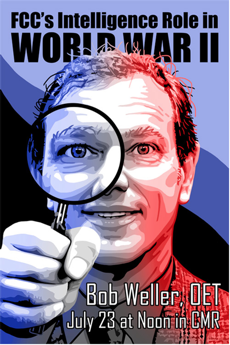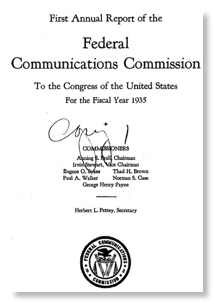FCC Media Bureau's Low Key Web Archive of Historic FCC Reports
The old FCC annual reports at the site are in .PDF format while the FRC reports use .JPG or .GIF images. This archive is not a key priority so little effort is spend on maintaining it.
There is another archive here that deals mostly with broadcasting issues but also includes historic tidbits like "FCC Order No. 1" describing the organization of FCC in 1934 and the original text of the Communications Act. This second archive is poorly indexed, but fascinating for academics and other researchers.
The archive is missing copies of FCC annual reports from 1966 - 1994.
While paper copies exist somewhere in FCC and they could conceptually be scanned into .pdf format, the current and pending low resource level at FCC make this a very low priority. However, contacts in the Commission indicate that they would be glad to add .pdf's of the missing annual reports to the archive for access by all if someone can provide them. Even a few would be nice.
So are there readers out there who can provide some of these missing FCC annual reports in .pdf or some other convenient format? Feel free to contact your blogger here.
FCC@80: Bob Weller's Farewell Talk to FCC on WWII-era Radio Intelligence Division
The ever mobile Bob is now joining NAB, effective today, as Vice President of Spectrum Policy reporting to Rick Kaplan, Executive Vice President of Strategic Planning - another FCC alum. It is rumored that he will be replacing Vic Tawil, another FCC alum, who is about to retire.

The FCC’s Radio Intelligence Division (RID) and the Foreign Broadcast Intelligence service (FBIS - later “Foreign Broadcast Information Service”) were formed on the eve of WWII to harness the then formidable and unique technical capabilities of FCC in support of the war effort.
As a result of the group sourcing, the following publicly available histories were found:
- The History of the Radio Intelligence Division Before and During World War II A collection of articles and manuscript of George E. Sterling,Chief, Radio Intelligence Division (1940-1946), FCC Commissioner (1948-1954) Edited by E. Merle Glunt & Albert A. Evangelista
- THE U.S. HUNT FOR AXIS AGENT RADIOS by George E. Sterling (From CIA website)
- Foreign Broadcast Information Service History (From CIA website)
- FBIS Against the Axis, 1941-1945 (From CIA website)
The video of Weller’s talk has is not on the FCC website, but has been uploaded to Dropbox. (Download by hitting the “download” button after using this link.)
(During Bob’s talk he worked in some mild criticism of FCC’s current engineering staffing system: FCC used to have central hiring of entry level engineers with recruiting tied to the academic year and a common training program in the former Norfolk VA field office and briefly at the Columbia MD field office. This program allowed competitive recruiting when other employers were recruiting as well as a common core of technical training for FCC engineers. [Realistically many electrical engineering degree programs today do not include much material on communications technology.] Such recruiting and training has been erratic for over a decade now due to budget uncertainties and may well be a problem in a few years as current senior engineers retire.)
One aspect of RID that was not mentioned is of great interest to your blogger and was not publicly known until the 1980s: FCC (along with FBI) disagreed with the Army on the disloyalty of Japanese-Americans after Pearl Harbor, particularly with the Army allegations that Japanese-Americans were transmitting information to Japan from covert transmitters. Peter Iron’s book Justice at War documents how both FCC Chairman James Fly and RID Chief George Sterling responded to requests from the Attorney General about the pending appeal of the Korematsu case to the Supreme Court.
In particular, Irons describes an April 1, 1944 memo to Attorney General Biddle from Chmn. Fly that left the AG “in a virtual state of shock”:
The FCC chairman provided documentation that (Army General) DeWitt had been personally informed by the FCC staff, both before his evacuation recommendation and afterward,that not one of the reports of illicit radio transmissions had been verified. .. (Fly wrote) “The fact is that military personnel was entirely incapable of determining whether or not the many reports of illicit signals were well founded. The basic trouble observed (by RID) was the lack of training and experience of military personnel carrying on the monitoring and direction-finding work.”…(Fly added that the Army) ”repeatedly made wholly inaccurate reports of illicit stations along the West Coast”. (p 282 - paperback edition)
Chmn. Fly also sent the AG summaries of George Sterling’s confrontational 1942 meetings with Gen. DeWitt, the main advocate of “internment/relocation” in which he heard DeWitt’s concerns about how “the woods were full of Japs with transmitters” and how Sterling wrote “I had never seen an organization so hopeless to cope with radio intelligence requirements”.
Since a major justification for the “internment/relocation” was “the interception of illicit radio transmissions” this unpleasant news from FCC to DOJ put DOJ in an awkward position as it prepared for the Korematsu case. So being bureaucrats, they solved the problem by “deep sixing” the FCC memos and fuzzifying their brief to the Supreme Court. The memos were rediscovered in the 1980’s by Korematsu’s legal team in a coram nobis petition and in September 1987 the 9th Circuit Court of Appeals granted the petition for Korematsu and the related Hirabayashi case, reversing their wartime convictions because it found if “suppressed (FCC) material been submitted to the Supreme Court its decision probably would have been materially affected ”.
While this seems like ancient history, recall what happened after 9/11 when speaking about civil rights became secondary to fear and constitutional concerns lost their primacy. For Fly and Sterling to speak out during WWII on the erroneous justification for the treatment of Japanese-Americans required supreme courage to go against the flow of the times. I believe that FCC should recognize and acknowledge the heroism of these two as one of FCC’s proudest contributions to our country.




![Validate my RSS feed [Valid RSS]](valid-rss-rogers.png)

